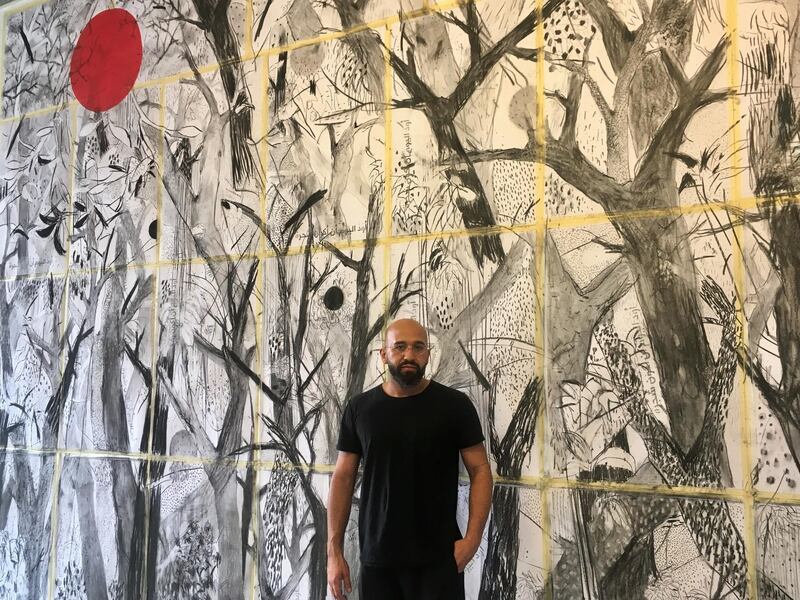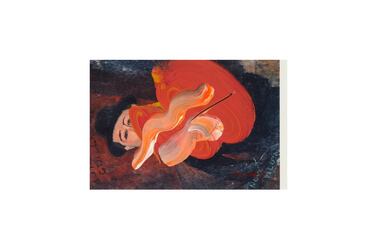On July 27, Lebanese artist Abed Al Kadiri was excited about the launch of his new show, Remains of the Last Red Rose, at the Galerie Tanit art space in Beirut. A week later, on August 4, a massive explosion at the Lebanese capital's port would tear through the heart of the city, killing at least 190 people, injuring thousands and leaving the nearby gallery in ruins.
"It took me five days to walk and see the port," Al Kadiri, who was overwhelmed by shock, tells The National. "When I saw all these people taking selfies, for me it was like we were recreating the same destructive images that I've been trying to avoid since day one."
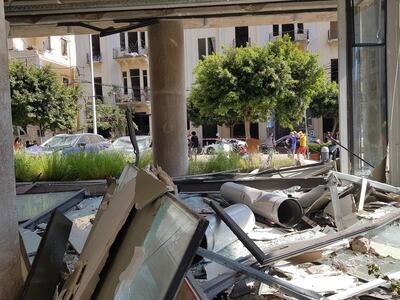
One month on, Al Kadiri wants to provide a more positive alternative to the grim sights and memories left in the wake of such devastation. He is transforming the shattered, empty space of Galerie Tanit into one bursting with life and vitality in a new project called Today, I Would Like to Be a Tree.
The first of two large murals sits completed on the remaining interior wall of the space, crisscrossed with yellow tape. It portrays an intricate forest of black and grey trees with the only colour coming from a deep, crimson sun in one distant corner.
"I conceived this project as a constructive reaction against the feeling of suffocation – be it suffocation from the recent pandemic, Lebanon's economic or political situation, or the world's biggest non-nuclear explosion. Observing the pain surrounding me, I had a recurring thought: 'I wanted to be a tree,'" Al Kadiri says.
"The tree is an alternative, perhaps even an antidote. Its roots embrace the earth from which it has sprung, in a reciprocal life-force loop. The tree endures and, by enduring, heals. I will be drawing trees: the trees of Beirut; the trees of my utopian dreams; the trees of change."
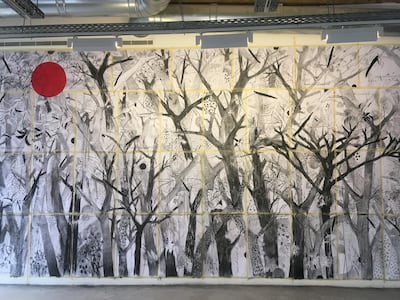
Since starting the new project, which will eventually comprise two murals divided into 80 individual charcoal drawings on cardboard, Al Kadiri’s aim has been to give a sense of serenity and peace to those struggling to put their lives back together in the badly affected Mar Mikhael neighbourhood.
The project – the product of long hours spent by Al Kadiri at the gallery – has been a point of curiosity for many who walk by the space.
"The amount of people that are passing by every day, whether I was working or taking a break, and how they are interacting with the work brings kind of a peace and satisfaction," Al Kadiri says. "I understand that there are a lot of people who are seeing hope in this," he adds, although the general sentiment is that people have grown tired from hanging on to hope alone.
Each of the 80 drawings will be available for purchase, with prices starting at $500 (Dh1,840), with all proceeds going directly to Bassma, an NGO founded in 2002 that works with underprivileged families. Through a renovation programme, Bassma is helping families affected by the blast to rebuild their homes.
"Each piece will be sold to support one family, or one house," Al Kadiri says. "They are focusing on the people who are really in financial need, who cannot even afford to change their windows or their doors."
At a personal level, the project is also a tribute to French-Lebanese architect Jean-Marc Bonfils. Bonfils was in his apartment in Beirut's East Village building, which houses Galerie Tanit on its ground floor. He died after being injured by the August 4 blast.
"The biggest loss for me was Jean-Marc Bonfils because he was the architect of the building," Al Kadiri says. "He was an artist, he was an architect, he was an art collector and, before all of this, he was a friend. My main concern is to create this counter-image to the destruction that happened in this space, to bring a beautiful spirit to the space itself by giving this as a tribute to Jean-Marc – because he created this building and he put a lot of energy into creating it."
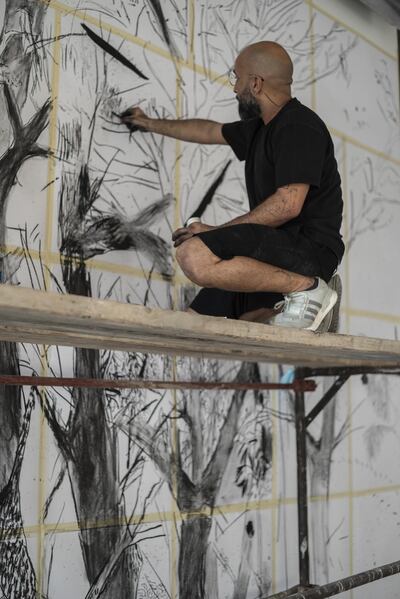
Al Kadiri is no stranger to approaching challenging subject matter in his art, but this time it is different. As he attempts to reconcile his own traumatic experience of the blast, he hopes that he can bring back some of the neighbourhood's atmosphere.
“I’ve always been dealing with humanitarian issues or with sociopolitical issues since I started my career,” he says, “but, with this specific project, I feel I’m doing something that is more efficient, more tangible. I’m doing this for the people.
“As a human, before being an artist, you discover that – for no reason – you start feeling guilty because you survived,” Al Kadiri says. “And then – because you see all the destruction around you – this feeling of guilt grows with time, and that was very suffocating for me.”
Originally, Al Kadiri planned to bring colours to Galerie Tanit and paint on the walls directly, but after being struck by the stark imagery of once-whole structures reduced to fragments, he decided to divide the mural into smaller pieces done in charcoal.
"I wanted to replicate this image by creating something that would reflect the buildings' facades, where all those people lost their windows and how what they can now see will always remind them of the blast," he says. "The whole piece makes one work and then, when you scatter these pieces, they will still remain as one whole and they bring the idea of unity again."
The use of this familiar medium also serves a more practical purpose. With Lebanon's rainy season fast approaching, Al Kadiri has thrown himself into work to raise the funds.
"It's a medium I know that I'm good at. It keeps my first and initial expression without any add-ons or colours, and also because I want to finish the work on a specific timeline. It's very challenging. I've been working almost 10 hours a day, and still I feel I need to work more."
